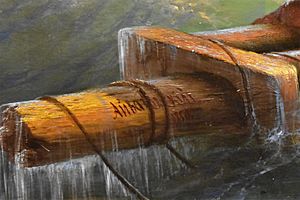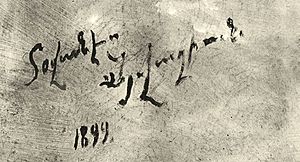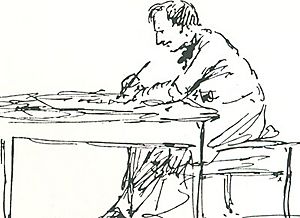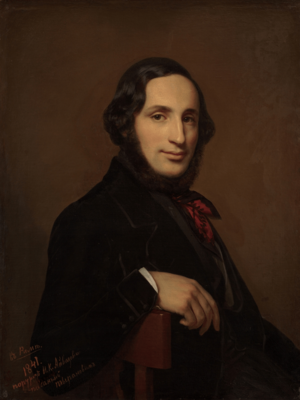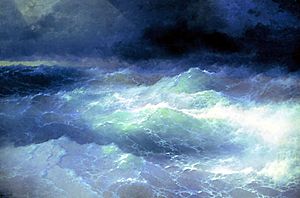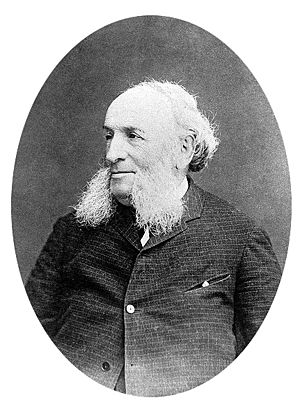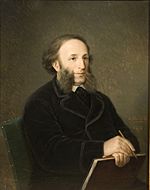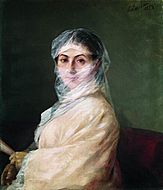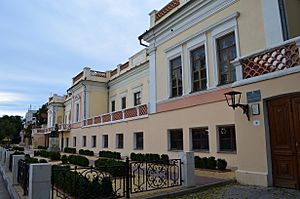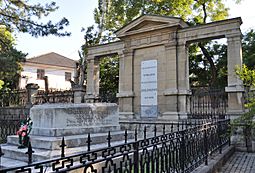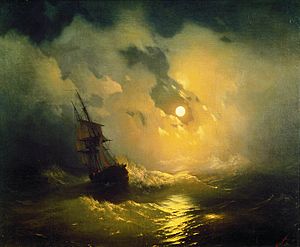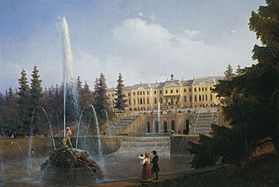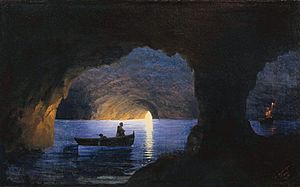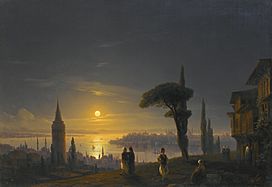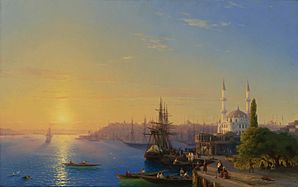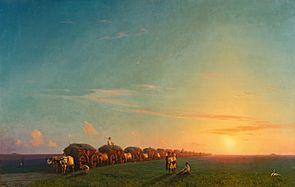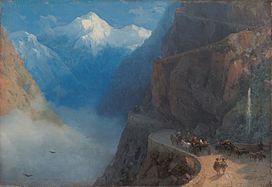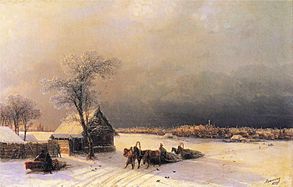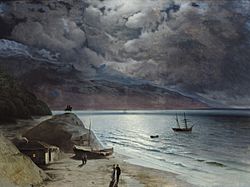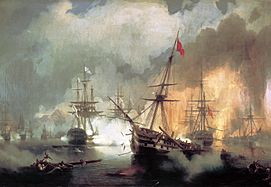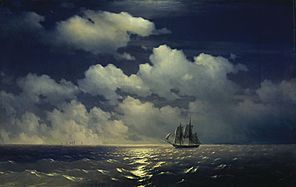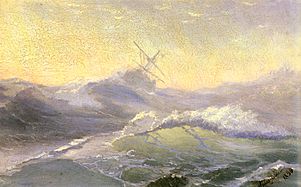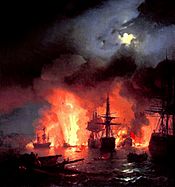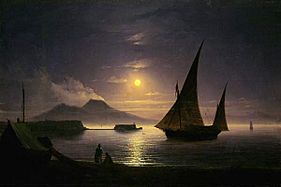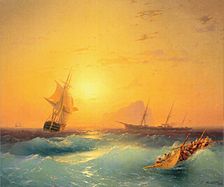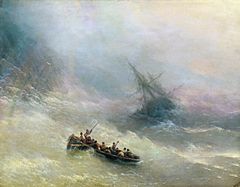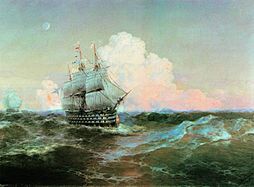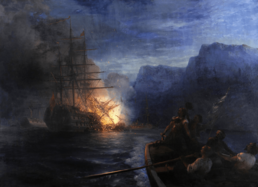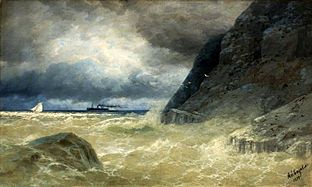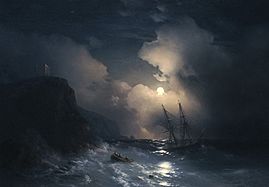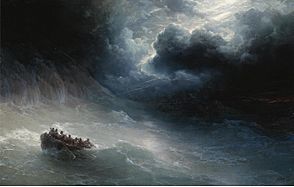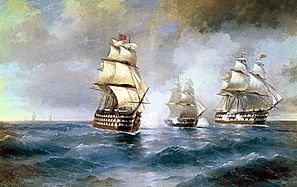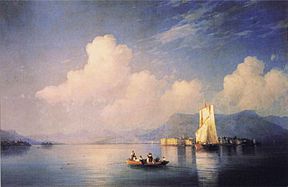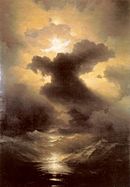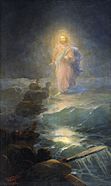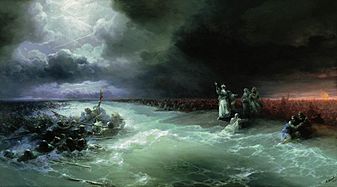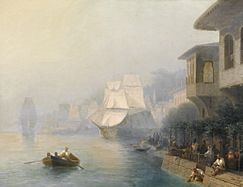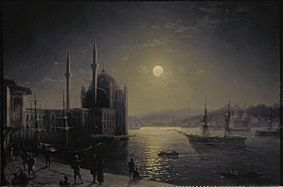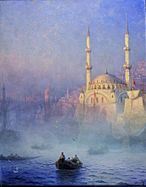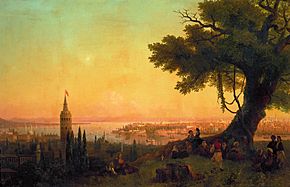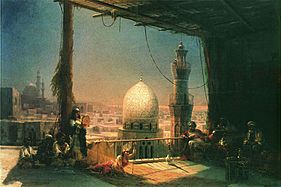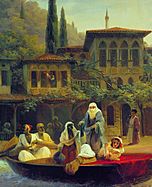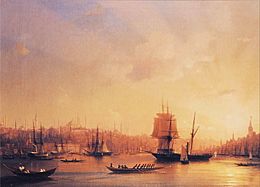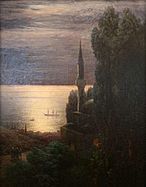Ivan Aivazovsky facts for kids
Quick facts for kids
Ivan Aivazovsky
|
|
|---|---|
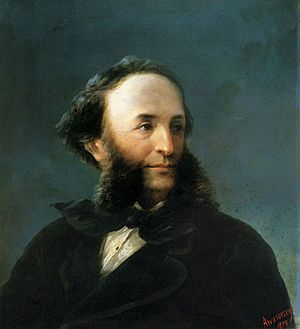
|
|
| Born | Hovhannes Aivazian 29 July [O.S. 17 July] 1817 Feodosia, Taurida, Russian Empire
|
| Died | 2 May [O.S. 19 April] 1900 (aged 82) Feodosia, Taurida, Russian Empire
|
| Resting place | St. Sargis Armenian Church, Feodosia |
| Education | Imperial Academy of Arts (1839) |
| Known for | Painting, drawing |
| Movement | Late Romanticism |
| Spouse(s) |
|
| Awards | See below |
Ivan Konstantinovich Aivazovsky (Russian: Иван Константинович Айвазовский; 29 July 1817 – 2 May 1900) was a famous Russian painter. He is known as one of the greatest artists who painted the sea. He was born as Hovhannes Aivazian into an Armenian family. His family lived in Feodosia, a port city in Crimea, which was part of the Russian Empire. He spent most of his life there.
After studying at the Imperial Academy of Arts in Saint Petersburg, Aivazovsky traveled to Europe. He lived in Italy for a short time in the early 1840s. When he returned to Russia, he became the main painter for the Russian Navy. Aivazovsky was close to important military and political leaders. He often went to military exercises. The government supported his work, and he was very well-known during his life.
A famous Russian writer, Anton Chekhov, once used the phrase "worthy of Aivazovsky's brush." This phrase became popular in Russia to describe something beautiful. Aivazovsky is still very popular in Russia today.
He was one of the most important Russian artists of his time. He was also famous outside of Russia. He had many art shows in Europe and the United States. During his nearly 60-year career, he created about 6,000 paintings. This made him one of the most productive artists ever. Most of his paintings show the sea, but he also painted battle scenes, Armenian stories, and portraits. Many of his artworks are in museums in Russia, Ukraine, Armenia, and Turkey, as well as in private collections.
Contents
Life of a Famous Painter
Early Life and Family
Ivan Aivazovsky was born on July 29, 1817, in Feodosia, Crimea. His birth name was Hovhannes Aivazian. His father, Konstantin, was an Armenian merchant. His mother, Ripsime, was also Armenian from Feodosia. They had five children, including Ivan's older brother, Gabriel Aivazovsky. Gabriel became a well-known historian and an Armenian archbishop.
School Days and Art Training
Young Aivazovsky first learned drawing from a local architect named Jacob Koch. In 1830, he moved to Simferopol and went to a Russian high school there. In 1833, he went to Saint Petersburg to study at the Imperial Academy of Arts. He learned landscape painting from Maxim Vorobiev.
Aivazovsky won a silver medal in 1835. He also met the famous Russian poet Alexander Pushkin in 1836. In 1837, he joined a class that taught battle painting. He even took part in naval exercises with the Baltic Fleet. He graduated from the Academy with a gold medal in October 1837, earlier than expected.
After graduating, Aivazovsky returned to Feodosia. He spent two years in his home region of Crimea. In 1839, he joined military exercises on the Crimean coast. There, he met important Russian admirals like Mikhail Lazarev and Pavel Nakhimov.
Traveling in Europe
In 1840, the Imperial Academy of Arts sent Aivazovsky to study in Europe. He first went to Venice, Italy. There, he visited San Lazzaro degli Armeni, an important Armenian monastery. His brother Gabriel lived there at the time. Aivazovsky studied old Armenian books and learned about Armenian art. He also met the Russian writer Nikolai Gogol in Venice.
He then traveled to other Italian cities like Florence, Naples, and Rome. Italian art and museums greatly influenced him. News of his successful art shows in Italy reached Russia. Even Pope Gregory XVI gave him a golden medal.
Aivazovsky also visited Switzerland, Germany, the Netherlands, and Britain. At an international art show in the Louvre in Paris, he was the only artist from Russia. He received a gold medal from the French Royal Academy of Painting and Sculpture. He was admired all over Europe. He returned to Russia in 1844.
Back in Russia and Family Life
When Aivazovsky came back to Russia, he became a member of the Imperial Academy of Arts. He was named the "official artist of the Russian Navy." His job was to paint seascapes, coastal scenes, and naval battles. In 1845, he traveled to the Aegean Sea with Duke Konstantin Nikolayevich. He visited Constantinople (now Istanbul) and Greek islands.
In 1845, Aivazovsky settled in his hometown of Feodosia. He built a house and an art studio there. He preferred a quiet life with a small group of friends and family. However, some critics felt that his art style became a bit old-fashioned. Russian art was changing from Romanticism to Realism, but Aivazovsky continued to paint Romantic seascapes.
In 1847, he became a professor of seascape painting at the Imperial Academy of Arts. He was also given a special noble title. In 1848, Aivazovsky married Julia Graves, an English governess. They had four daughters. They later separated in 1860 and divorced in 1877.
Growing Fame
In 1851, Aivazovsky traveled with the Russian emperor Nicholas I to Sevastopol for military exercises. When the Crimean War started in 1853, he was moved to safety. But he returned to the city of Sevastopol, which was under attack, to paint battle scenes. His paintings were shown there even while the city was under siege.
Between 1856 and 1857, Aivazovsky worked in Paris. He became the first Russian artist to receive the Legion of Honour, a very important French award. In 1857, he visited Constantinople and received the Order of the Medjidie from the Ottoman Empire. He also received awards from Greece and Russia in the following years.
Aivazovsky opened his own art studio in Feodosia in 1865. The Imperial Academy of Arts also started paying him a salary.
More Travels and Awards
In the 1860s, Aivazovsky painted scenes inspired by Greek and Italian history. In 1868, he visited Constantinople again. He created paintings about the Greek resistance against the Turks. Later that year, he traveled to the Caucasus region and visited Russian Armenia for the first time. He painted many mountain landscapes.
In 1869, he went to Egypt and attended the opening of the Suez Canal. He was the first artist to paint the Suez Canal, marking a big moment in history.
In 1870, Aivazovsky received a high civil rank in Russia. In 1871, he helped build an archaeological museum in Feodosia. In 1874, the Florence Academy of Fine Art in Italy asked him for a self-portrait to display in the famous Uffizi Gallery. The same year, the Ottoman Sultan invited Aivazovsky to Constantinople and gave him another Turkish award.
Aivazovsky continued to travel and exhibit his art in many European cities throughout the 1870s and 1880s. In 1880, he opened an art gallery in his Feodosia home. It was one of the first public museums in the Russian Empire.
Later Life and Second Marriage
Aivazovsky's second wife, Anna Burnazian, was a young Armenian widow. They married in 1882. Aivazovsky said that marrying her made him feel "closer to [his] nation," meaning the Armenian people. In the 1880s, he traveled through Russia, including along the Volga River.
In 1885, he received another high rank in Russia. In 1886, his 50th year as an artist was celebrated with a big exhibition in Saint Petersburg.
In 1892, he visited the United States, seeing Niagara Falls and Washington D.C. In 1896, at 79 years old, he received his highest civil rank.
Aivazovsky was very upset by terrible events that happened to Armenians in the Ottoman Empire between 1894 and 1896. He painted several works about these events. He even threw the medals given to him by the Ottoman Sultan into the sea. He told the Turkish consul, "Tell your master that I've thrown away all the medals given to me. Here are their ribbons. Send them to him, and if he wants, he can throw them into the seas painted by me."
He spent his last years in Feodosia. Thanks to his efforts, a commercial port was built in Feodosia. It was connected to the Russian railway system. The railway station, opened in 1892, is now named Ayvazovskaya. Aivazovsky also helped provide drinking water to Feodosia.
His Death and Legacy
Aivazovsky died on May 2, 1900, in Feodosia. He was buried in the courtyard of the St. Sargis Armenian Church, as he wished. His tombstone has a quote in Armenian that means: "He was born a mortal, left an immortal legacy."
His wife, Anna, lived a quiet life after his death. She was buried next to him in 1944.
Aivazovsky's Artworks
During his 60-year career, Aivazovsky created about 6,000 paintings. While some are masterpieces, others are simpler works. Some people even say he painted as many as 20,000! Most of his paintings show the sea. He rarely painted land scenes and only a few portraits.
Aivazovsky was known for his amazing memory. He could paint what he had seen without making any sketches first. He was very good at showing moving water and how sunlight or moonlight reflected on it.
Art Shows and Exhibitions
Aivazovsky held 55 solo exhibitions during his career, which was a huge number for his time. Some of his most important shows were in Rome, Paris, Amsterdam, Moscow, and London.
He also showed his art in many group exhibitions. These included shows at the Imperial Academy of Arts, the Paris Salon, and World Exhibitions in cities like Paris, London, and Chicago.
His Painting Style
Aivazovsky was mainly a Romantic painter, but he also used some Realistic elements. He stayed true to his Romantic style throughout his life. His early works were influenced by his teachers at the Academy. Other classic painters also helped shape his unique style.
His best paintings from the 1840s and 1850s used many colors and were grand and romantic. Many experts consider his painting The Ninth Wave to be his best work. By the 1870s, his paintings used softer colors. In his last 20 years, he created many seascapes with a silvery tone.
As Russian art moved towards Realism, Aivazovsky's Romantic style sometimes faced criticism. This might have been because he lived in Feodosia, a quiet town far from the big art centers of Moscow and Saint Petersburg. His way of thinking was also considered a bit old-fashioned compared to new art trends.
Later in his career, Aivazovsky painted dramatic scenes on a larger scale. He showed the struggle between people and the power of the sea, like in The Rainbow (1873). He also painted "blue marines" and city scenes like Moonlit Night on the Bosphorus (1894).
Types of Paintings
Landscapes
-
View of a Fountain and Peterhof Palace (1837)
-
View of Tiflis from Seid-Abaz (1868)
-
Moscow in Winter from the Sparrow Hills (1872)
Seascapes
-
Battle of Navarino (1848)
-
Bay of Naples (1842)
-
American Shipping off the Rock of Gibraltar (1873)
-
The burning of the Turkish flagship by Kanaris (1881)
-
Lake Maggiore in the Evening (1892)
Religious Paintings
Paintings of Eastern Places
-
View of Constantinople by Evening Light
-
Scenes from Cairo's Life
Armenian Themes in Art
Aivazovsky's early works included Armenian themes. In 1868, he finally visited his family's homeland, Russian Armenia. He painted scenes of Mount Ararat, the Ararat plain, and Lake Sevan. He was the first Armenian artist to paint Mount Ararat.
He continued painting Armenian-themed works in the 1880s. These include Valley of Mount Ararat (1882) and Descent of Noah from Ararat (1889). His Armenian signature, "Aivazian," appears on Valley of Mount Ararat. He also painted famous Armenians, like his brother Archbishop Gabriel Aivazovsky. His paintings The Baptism of Armenians and Oath Before the Battle of Avarayr (both 1892) show important moments in ancient Armenian history.
-
Descent of Noah from Ararat (1889). National Gallery of Armenia
-
Lord Byron's visit to San Lazzaro degli Armeni (1899)
Aivazovsky's Impact and Recognition
Aivazovsky was the most important seascape painter in 19th-century Russian art. He was the first and for a long time the only artist focusing on seascapes. Other artists who painted the sea were either his students or were influenced by him.
Artists like Arkhip Kuindzhi and Vartan Makhokhian were influenced by Aivazovsky's work. His grandsons, Mikhail Latri and Aleksey Ganzen, also became painters influenced by him.
How He Was Seen
Aivazovsky was one of the few Russian artists who became famous during his lifetime. He is seen as one of the greatest marine artists of the 19th century, both in Russia and worldwide. He was also one of the few Russian artists to become well-known outside of Russia.
In 19th-century Russia, his name became a symbol of art and beauty. The phrase "worthy of Aivazovsky's brush" was used to describe something incredibly lovely.
A street in Moscow was named after Aivazovsky in 1978. A statue of him was put up in Kronstadt in 2007. In 2018, the Simferopol International Airport in Crimea was named after him. A bust of Aivazovsky was placed in front of the airport in 2020.
In a 2017 poll, Aivazovsky was voted the most favorite artist by Russians. About 27% of people chose him as their favorite.
His Place in Armenia
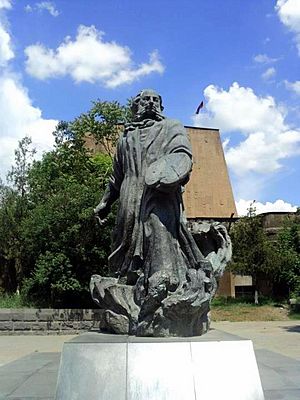
In Armenia, Aivazovsky is seen as an Armenian painter. He is often called by his Armenian name, Hovhannes. He is considered the most important Armenian painter of the 19th century and the first Armenian marine painter. He even signed some of his paintings and letters in Armenian.
The famous Armenian poet Hovhannes Tumanyan wrote a short poem about an Aivazovsky seascape in 1893. The National Gallery of Armenia in Yerevan has about 100 of Aivazovsky's works. Some of these paintings are displayed in the Presidential Palace in Yerevan.
A statue of Aivazovsky was put up in central Yerevan in 2003. A bust was also placed in Stepanakert in 2021. Aivazovsky is even on the 20,000 Armenian dram banknotes issued in 2018.
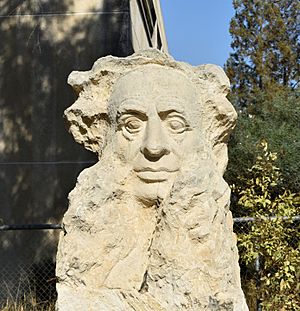
Aivazovsky in Turkey
Aivazovsky's paintings were popular in the Ottoman court in the 19th century. As of 2014, about 30 of his paintings are in Turkish museums. Many of his works are in former Ottoman palaces and military museums. When Abdullah Gül became president of Turkey in 2007, he had Aivazovsky's paintings displayed in his office. Today, the walls of the new Presidential Complex in Ankara are also decorated with Aivazovsky's art.
Aivazovsky in Ukraine
In Ukraine, Aivazovsky is sometimes considered a Ukrainian painter. He painted many Ukrainian landscapes, including scenes of the Dnieper, the Ukrainian steppe, and Odesa. An alley in Kyiv was named after him in 1939. A statue of Aivazovsky and his brother Gabriel was put up in Simferopol, Crimea, in 1999.
Lasting Legacy
Aivazovsky's house in Feodosia, where he opened an art museum in 1880, is still open today. It is called the Aivazovsky National Art Gallery. It is a main attraction in the city and has the largest collection of his paintings in the world. A statue of the artist stands in front of the museum.
Honors After His Death
Many countries have issued postage stamps showing Aivazovsky or his artworks. These include the Soviet Union, Romania, Armenia, Russia, and Ukraine. A small planet, 3787 Aivazovskij, was named after him in 1977.
In 2016 and 2017, major art shows were held in Russia, Ukraine, and Armenia to celebrate Aivazovsky's 200th birthday. An exhibition with 120 paintings was held at the Tretyakov Gallery in Moscow. It attracted a record number of visitors.
Art Auctions
Aivazovsky's paintings became very popular at art auctions in the early 2000s, especially in London. Many of his works have been bought by wealthy collectors. In 2004, his painting Saint Isaac's Cathedral On A Frosty Day sold for about $2.1 million. In 2007, American Shipping off the Rock of Gibraltar sold for £2.71 million, much more than expected. In April 2012, his painting View of Constantinople and the Bosphorus sold for a record $5.2 million. In 2020, The Bay of Naples sold for $2.8 million, setting a record for an online-only art auction.
Images for kids
See also
 In Spanish: Iván Aivazovski para niños
In Spanish: Iván Aivazovski para niños
- Russian culture
- Armenian culture
- Armenians in Crimea


